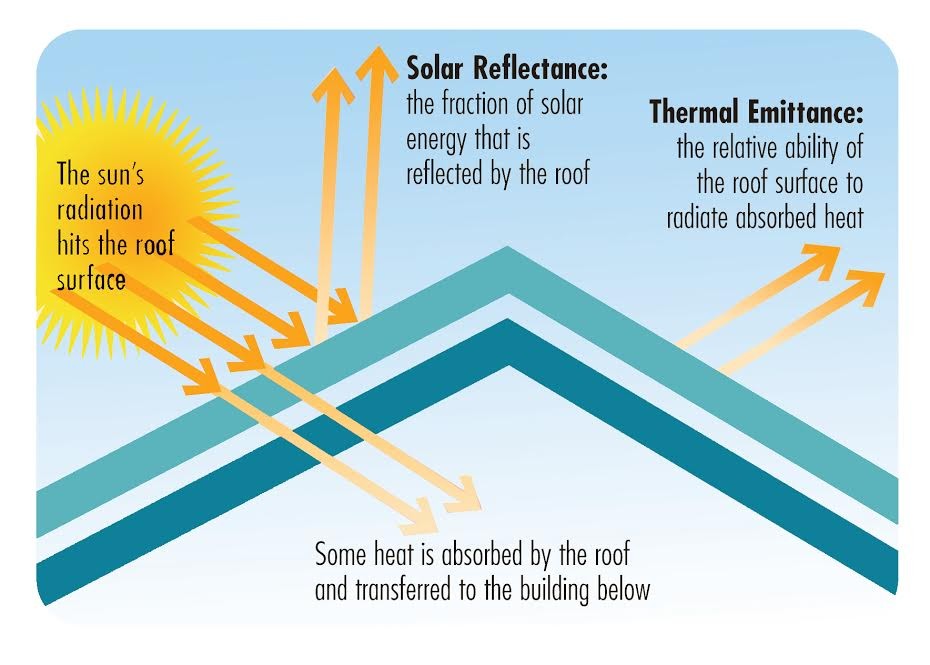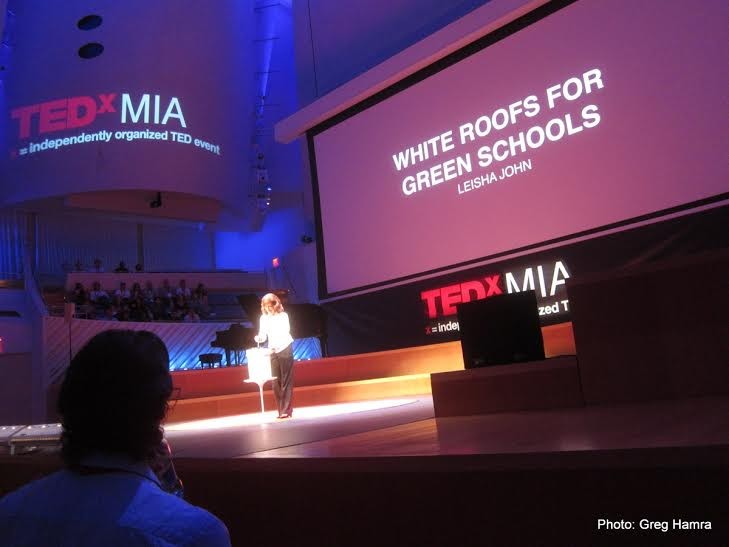By. Leisha John, Americas Director of Environmental Sustainability for EY
As an environmental sustainability professional and a proponent of greening schools, I am inspired by the ingenious and innovative ways in which schools are approaching sustainability. I am also aware that by reducing energy consumption, schools can free up funds to invest in a better educational experience for their students. This led me to borrow an idea I had seen in the private sector and White Roofs for Green Schools was born.
What is a White Roof?
A white roof is simply a rooftop that has been painted with a solar reflective white coating. This coating reflects up to 90% of sunlight as opposed to traditional black rooftops which reflect only 20%. As a result, a white roof can keep a building cooler, especially in the summer, thus reducing the demand for air conditioning. According to the White Roof Project, white roofs have the potential to reduce summer energy use by 10-40%, saving money and preventing pollution. In fact, white roofs are effective in all kinds of climates, not just hot, sunny ones. White roofs have proven effective in states like Illinois, New Jersey, New York, and Pennsylvania in addition those found in Arizona, California, and Florida.

Photo Courtesy of Cool Roof Rating Council
Schools can reap a number of benefits from white-coating their dark rooftops, including:
- Lower utility bills, which frees up funds for better uses, like computers and textbooks.
- Reducing environmental impact (through a reduced demand for energy).
- Adding years of longevity to school building(s) while deferring costly roof repairs / replacement.
- Keeping teachers healthier by reducing voice strain from talking over blasting air conditioners.
- Reducing the urban ‘heat island’ effect (i.e., keep your surrounding community cooler). The community benefits through lowered carbon emissions, cleaner air, and lower cooling costs.
- Providing a healthier environment for students to learn. Less mold and cleaner air means reduced asthma rates and fewer sick days.
- Promoting schools as ’teaching tools’ for students, teachers, and parents.
White Roof Success Story: Our Savior’s Elementary School
Our Savior’s Elementary School in Cocoa Beach, FL is a prime example of a school that benefited from converting to a white-coated roof. The small private school was approached by the Florida Solar Energy Center (FSEC) in the early 1990s to participate in a study they were conducting on the efficacy of highly reflective roof coatings. The school recognized this as an opportunity to improve its infrastructure and agreed to participate.
In May 1995, a simple white acrylic coating was applied to the roof of Our Savior’s Elementary School. Initially, FSEC was able to determine that the reflectivity of the roof increased from 23% to 68%. FSEC continued to monitor the school for a year after the white-coating was applied and noted several impressive findings:
- The chiller’s annual energy consumption had declined by approximately 13,000 kWh and its annual average electric power demand was reduced by 10%.
- During periods when electric power rates were highest (e.g., summer weekdays), peak electric power demand had fallen by 35%.
- Our Savior’s Elementary School saved $850 in annual energy costs.
Less quantifiable were the intangible benefits realized by students and faculty. Lower temperatures in the school building improved classroom conditions and made the environment more comfortable for learning and teaching.
4 Steps to a White Roof
Converting your school rooftop to a white roof is simple, cheap, and doable. Here are four steps I recommend taking to bring white roofs to your schools:
- View and share my TEDx Talk “White Roofs for Green Schools” with your school district’s Head of Facilities. He or she will be able to determine which roofs are suitable for white-coating in your district, depending on the age, overall condition, warranty, and slope of the roof.
- Do research to determine the best method for financing your white roof project. One of the best ways is through rebates offered by your local utility for ‘cool roofs.’ In addition, check with your state and city to see if they may offer additional incentives.
- Contact white or cool roof distributors in your area. These companies may offer to donate the coating in exchange for the utility rebates or tax credits.
- If possible, organize volunteers to do the coating to avoid the cost for labor. In addition to school facilities staff, invite teachers, parents, and local businesses to get involved. If this is not an option, see if your utility company is willing to train the school facilities staff to spread the coating themselves.

Photo Courtesy of Greg Hamra
Since I gave my TEDx talk in 2012, the idea of white-coating roofs has spread across Miami Dade County, FL (where I call home). Out of our 400 schools, approximately 75 have been white-coated to date. If all 34 million square feet of school rooftops are white-coated, the Miami-Dade School District could save an estimated $400 million in utility bills over ten years!
Will your school be next?
References
EPA’s Energy Star Case Study on Our Savior’s Elementary School in Cocoa Beach, FL
White Roof Project FAQ webpage
About Leisha John:
Leisha John is the Americas Director of Environmental Sustainability for EY, one of the world’s largest professional services organizations providing audit, tax, transaction, and risk advisory services. In her role, Leisha works with the firm’s leaders to develop and implement strategies to reduce EY’s impact on the environment. Her current focus is measuring EY’s carbon footprint, applying best practices in sustainability to the organization’s business processes and infrastructure, sustainability and carbon reporting, and engaging employees in adopting more eco-friendly ways of working.
Leisha is a Certified Public Accountant and a LEED AP (Leadership in Energy and Environmental Design – Accredited Professional) based in Miami, Florida. In 2014, she was named one of The 10 Most Powerful Women in Sustainability by gb&d magazine. Leisha is passionate about greening schools and has delivered a TEDx Talk on the subject of ‘white roofs for green schools.’
